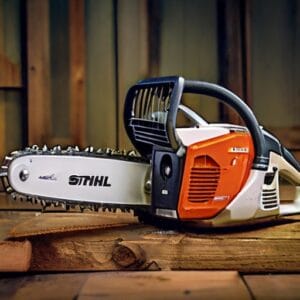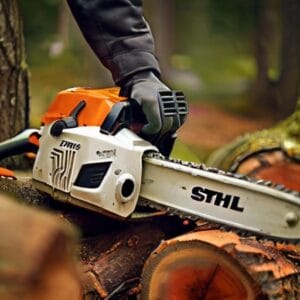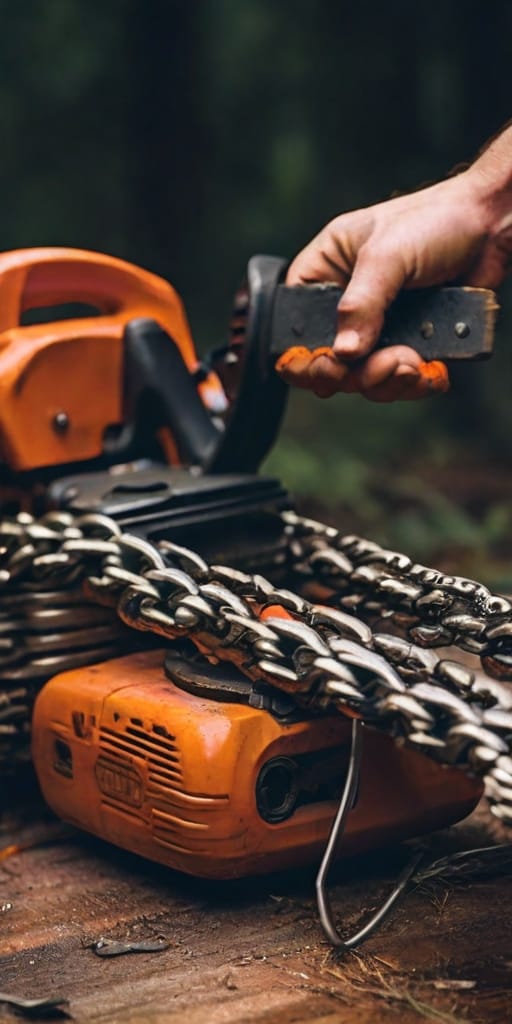Do you need to know how to measure a chainsaw bar? Maybe you are looking to replace your chainsaw bar or chain, but you’re not sure what size it takes? If so, I can help. I’ll show you the easiest methods for measuring a chainsaw bar and chain length. These tips are perfect for anyone who has lost their product manual or had the stamped measurements wear off the side of the chainsaw blade. I’ll first answer, “How do you measure a chainsaw bar?”, then move on to “How do you measure a chainsaw chain?”. Let’s get started!

Measuring a Chainsaw Bar
As a carpenter, accurate measurements are fundamental. Measuring your chainsaw bar is simpler than you might think. Follow these steps to get the correct size:
- Measure the Bar Length: To measure the chainsaw bar, start by measuring from the tip of the bar to where it enters the chainsaw’s body in a straight line. This gives you the usable length of the bar. Ensure the bar is straight while measuring. Most chainsaw bars come in standard sizes like 14, 16, 18, or 20 inches.
- Total Length: After measuring the usable length, you can also measure the total length of the bar. This is the length from the tip to the end that fits inside the chainsaw. However, the usable length is usually sufficient when ordering parts.
Measuring a Chainsaw Chain
Measuring the chain is just as crucial as measuring the bar. To ensure your chainsaw works efficiently, you need the correct chain. Here’s how to measure it:
- Chain Length: The chain length is determined by the number of drive links. Remove the chain from your saw and count the drive links. This number indicates the chain length.
- Pitch: The pitch of the chain refers to the distance between any three consecutive rivets, divided by two. Measure this distance and divide by two to get the pitch. Common pitch measurements are 1/4 inch, 3/8 inch, or 0.325 inch.
- Gauge: The gauge of the chain is the thickness of the drive links that fit into the bar. Use a caliper to measure this thickness. Typical gauges are 0.050 inch, 0.058 inch, or 0.063 inch.
Carpenter’s Tips
As a carpenter, maintaining your chainsaw’s efficiency and upkeep is crucial for the quality of your work. Here are some tips:
- Regular Maintenance: Regularly check and oil your chainsaw bar and chain. This prolongs the life of your saw and ensures better performance.
- Use the Right Parts: Always use the correct size bar and chain for your chainsaw. Incorrect sizes can negatively impact performance and pose safety risks.
- Keep it Sharp: Regularly check the sharpness of the bar and chain. Dull blades make your job harder and can be dangerous.

Are You Replacing Parts on an Older Chainsaw?
If you’re reading this post and considering replacing the bar or chain on an older chainsaw, you might want to check out my other guide on the best budget chainsaw options. A new bar or chain can cost around $20 to $50 each (or $40 to $100 in total). If you put that money into a newer chainsaw, it’ll come with those parts already installed. You may also get a better chainsaw altogether. So, take a look at that guide when you have a chance. At the very least, it’s something worth considering. Or, if you want to see what else is available, I also have a post on the top chainsaws. It includes 10 of the best chainsaws separated by type: gas, electric, and battery powered.
Chatting About Measuring a Chainsaw Bar and Chain
As a carpenter, I know how crucial it is to use and maintain a chainsaw properly. Are you thinking about replacing the bar or chain on your old chainsaw but aren’t sure about the right size? Don’t worry, it’s simpler than you think.
Measuring the Bar First, let’s talk about how to measure the chainsaw bar. Start by measuring in a straight line from the tip of the bar to where it enters the chainsaw’s body. This gives you the usable length of the bar. Most chainsaw bars come in standard sizes like 14, 16, 18, or 20 inches. Make sure the bar is straight while you measure.
Measuring the Chain Now, let’s move on to measuring the chain. The chain length is determined by the number of drive links. Remove the chain from your saw and count the drive links. This number tells you the chain length. The chain’s pitch is the distance between any three consecutive rivets divided by two. Measure this distance and divide it by two to get the pitch, which is usually 1/4 inch, 3/8 inch, or 0.325 inch. The gauge of the chain, which is the thickness of the drive links that fit into the bar, can be measured with a caliper and is typically 0.050 inch, 0.058 inch, or 0.063 inch.
Carpenter’s Tips As a carpenter, I’d like to emphasize the importance of regular maintenance and using the correct parts for your chainsaw. Regularly check and oil your chainsaw bar and chain to prolong the life of your saw and ensure better performance. Always use the correct size bar and chain; incorrect sizes can negatively affect performance and pose safety risks. Also, regularly check the sharpness of the bar and chain. Dull blades make your job harder and can be dangerous.
You might also consider investing in a new chainsaw. Given the cost of a new bar or chain, investing in a new chainsaw might make more sense. This way, the parts are already installed, and you can work more efficiently.
How to Measure a Chainsaw Bar (Blade) Length
Let me share something interesting with you. Not all chainsaws are built to handle every bar length. Longer bars demand more engine power. That’s why electric chainsaws are limited to an 18-inch blade; their motors simply aren’t powerful enough to drive a longer bar and chain. On the other hand, some gas chainsaws can handle bars as long as 72 inches because they have the robust engines to support it.
Another important point: chainsaw chains don’t stretch. Each chain is made to fit a specific bar size. If the chain is too short or too wide for the bar, it just won’t fit. But don’t worry, I’ll explain how to measure a chainsaw bar so you can find the perfect replacement part.
Chatting About Chainsaw Bar and Chain Measurements
As a carpenter, I’ve often had to measure and replace chainsaw bars and chains. Let’s break it down in a way that’s easy to understand.
Measuring the Chainsaw Bar When you’re measuring your chainsaw bar, there are two key lengths you need: the effective length and the true length.
- Effective Length: This is the length from the tip of the bar to where it enters the chainsaw’s body. It’s the part of the bar that is actually used for cutting. Grab a tape measure and measure this distance. Most common sizes you’ll encounter are 14, 16, 18, and 20 inches, but it can vary.
- True Length: This is the total length of the bar from tip to end, including the part that goes inside the chainsaw. While this measurement is less commonly needed, it’s good to know, especially if you’re comparing bars.
Measuring the Chainsaw Chain Next, let’s discuss the chain. Here are the key points:
- Chain Length: This is determined by counting the number of drive links (the small, tooth-like sections that fit into the bar). Take the chain off the saw and count these links. This number is crucial for finding the right chain length.
- Pitch: The pitch is the distance between three consecutive rivets divided by two. Measure this distance and divide by two to get the pitch. Common pitch sizes include 1/4 inch, 3/8 inch, or 0.325 inch.
- Gauge: This is the thickness of the drive links that fit into the bar’s guide groove. You can measure this with a caliper. Standard gauges are 0.050 inch, 0.058 inch, or 0.063 inch.
Carpenter’s Advice From my experience as a carpenter, here are a few tips to ensure your chainsaw is always in top shape:
- Regular Maintenance: Consistently check and oil your chainsaw bar and chain. This maintenance prolongs the life of your saw and ensures it runs smoothly.
- Correct Parts: Always use the correct bar and chain sizes. Using the wrong size can reduce performance and create safety hazards.
- Keep It Sharp: Regularly sharpen your chainsaw blade and chain. Dull blades make your work harder and can be dangerous.
Effective Cutting Length (Or Called Length)
Hey everyone, let’s talk about measuring chainsaw bars. It’s really straightforward once you know what to do. There are two key measurements you need to know: the effective cutting length and the true length. As a carpenter, I can tell you that getting these measurements right is crucial for your chainsaw’s performance.
Effective Cutting Length
Effective Cutting Length: This is the easiest measurement to find and is often referred to as the “called length.” It’s the length from the tip of the blade to the base where it attaches to the chainsaw.
How to Measure It:
- Grab a Tape Measure: Start at the base of the blade where it attaches to the chainsaw.
- Stretch to the Tip: Extend the tape measure to the tip of the blade.
- Round Up: Whatever measurement you get, round it up to the nearest even number. For instance, if your blade measures 18 1/2 inches, round up to 20 inches. If it’s 15 3/4 inches, round up to 16 inches.
So, the effective cutting length is simply the part of the blade that does the actual cutting, rounded up for convenience.
True Length
True Length: This is the full length of the blade from tip to end, and it requires a bit more effort to measure because you need to remove the blade from the chainsaw.
How to Measure It:
- Remove the Blade: Unscrew the bolts on the right side of the chainsaw that hold the blade in place. These bolts are usually located just past the base of the bar.
- Lay It Flat: Once removed, place the blade flat on a table or the ground.
- Measure End to End: Measure the entire length from one end to the other. Unlike the effective length, there’s no need to round up; just take the exact measurement.
Carpenter’s Tips
From my experience as a carpenter, here are some additional insights:
- Maintenance is Key: Regularly check and oil your chainsaw bar and chain. This keeps your chainsaw running smoothly and extends its lifespan.
- Use Correct Parts: Always use the right bar and chain sizes. Using incorrect sizes can impact performance and safety.
- Sharpen Regularly: Ensure your chainsaw blade and chain are sharp. Dull blades can make your work harder and pose safety risks.
